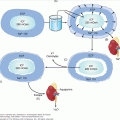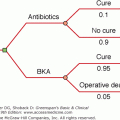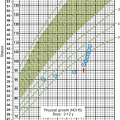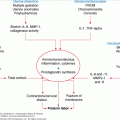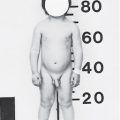Appendix: Normal Hormone Reference Ranges
View Large | | Print
Normal Hormone Reference Rangesa,b
| Test | Source | Ages, Conditions, etc | Conventional Units | Conversion Factor | SI Units | Comments |
|---|---|---|---|---|---|---|
| Adrenocorticotropic hormone (ACTH) stimulation test (cosyntropin test): 0.25 mg of synthetic ACTH1-24 (cosyntropin) is administered IV or IM, and serum cortisol is measured at 0, 30, and 60 min. Normal response: peak cortisol >20 μg/dL (>540 nmol/L). A dose of 1 μg of ACTH will give a similar response in the normal individual (see Chapter 9). | ||||||
| ACTH | Plasma | Men | 7-50 pg/mL | 0.222 | 1.55-11.1 pmol/L | Collect in silicone-coated EDTA-containing tubes. Keep iced. Avoid contact with glass during collection and separation. Process immediately. Separate and freeze plasma in plastic tube at −20°C. |
| Women | 5-27 pg/mL | 1.11-6 pmol/L | ||||
| Children | ||||||
| Prepubertal | 7-28 pg/mL | 1.55-6.2 pmol/L | ||||
| Postpubertal | 2-49 pg/mL | 0.44-10.78 pmol/L | ||||
| Post-dexamethasone suppression | 2-5 pg/mL | 0.4-1.1 pmol/L | ||||
| Aldosterone | Serum (fasting) | Sodium intake | – | 27.7 | ||
| 300 mmol/d: | ||||||
| Adult | Levels in pregnant patients are three to four times higher. | |||||
| Upright am | <28 ng/dL | <776 pmol/L | ||||
| Upright pm | <21 ng/dL | <582 pmol/L | ||||
| Supine am | 3-16 ng/dL | 83.1-443 pmol/L | ||||
| Adrenal vein | 200-400 ng/dL | 5540-11,080 pmol/L | ||||
| Urine | Sodium diet | – | – | Collect 24-h specimen in 10 g boric acid to maintain pH <7.5. Refrigerate during collection. | ||
| (100-300 mmol/d) | ||||||
| Children: | ||||||
| 2-7 y | ≤5.7 μg/d | |||||
| 8-11 y | ≤10.2 μg/d | |||||
| 12-16 y | ≤15.6 μg/d | |||||
| Adult | ≤2.3-21 μg/d | |||||
| Post-fludrocortisone or intravenous saline infusion | ≤5.0 μg/d | |||||
| Alkaline phosphatase, bone specific | Serum | 2-24 mo | 25.4-124.0 μg/L | – | – | IRMA; collect following an overnight fast; useful in Paget disease and osteoporosis; assay also known as Ostase; increased levels seen in states of high bone turnover (Paget disease, hyperthyroidism, osteoporosis). |
| 6-9 y | 41-134.6 μg/L | |||||
| 10-13 y | ||||||
| Males | 43.8-177.4 μg/L | |||||
| Females | 24.2-154.2 μg/L | |||||
| 14-17 y | ||||||
| Males | 3.7-128 μg/L | |||||
| Females | 110.5-75.2 μg/L | |||||
| Adult males | ||||||
| 18-29 y | 8.4-29.3 μg/L | |||||
| 30-39 y | 7.7-21.3 μg/L | |||||
| 40-49 y | 7.0-18.3 μg/L | |||||
| 60-68 y | 7.6-14.9 μg/L | |||||
| Adult females | ||||||
| 18-29 y | 4.7-17.8 μg/L | |||||
| 30-39 y | 5.3-19.5 μg/L | |||||
| 40-49 y | 5.0-18.8 μg/L | |||||
| 50-76 y | 5.6-29 μg/L | |||||
| Alpha subunit | Serum | Men | <0.6 ng/mL | – | – | RIA; used to assess gonadotropin hormone subunit secretion in pituitary adenomas. |
| Women | ||||||
| Premenopausal | <1.5 ng/mL | |||||
| Postmenopausal | 0.9-3.3 ng/mL | |||||
| Hypothyroid | <3.7 ng/mL | |||||
| Pregnant or hCG-producing tumor | 1.8-360 ng/mL | |||||
| 3α-Androstenediol glucuronide | Serum | Prepubertal children | 0.1-0.6 ng/mL | 2.14 | 0.2-1.3 nmol/L | Freeze serum and store at −20°C. |
| Tanner II-III | ||||||
| Male | 0.19-1.64 ng/mL | 0.41-3.51 nmol/L | ||||
| Female | 0.33-2.44 ng/mL | 0.71-5.22 nmol/L | ||||
| Adult | ||||||
| Male | 2.6-15 ng/mL | 5.6-32.1 nmol/L | ||||
| Female | 0.6-3.0 ng/mL | 1.3-6.4 nmol/L | ||||
| Androstenedione | Serum | Men | 3.49 | |||
| 18-30 y | 50-220 ng/dL | 175-768 nmol/L | ||||
| 31-50 y | 40-190 ng/dL | 140-663 nmol/L | ||||
| 51-60 y | 50-220 ng/dL | 175-768 nmol/L | ||||
| Women | ||||||
| Follicular | 35-250 ng/dL | 122-873 nmol/L | ||||
| Midcycle | 60-285 ng/dL | 209-995 nmol/L | ||||
| Luteal | 30-235 ng/dL | 105-820 nmol/L | ||||
| Postmenopausal | 20-75 ng/dL | 70-262 nmol/L | ||||
| Children | ||||||
| 1-12 mo | 6-78 ng/dL | 21-272 nmol/L | ||||
| 1-4 y | 5-51 ng/dL | 17-178 nmol/L | ||||
| 5-9 y | 6-115 ng/dL | 21-401 nmol/L | ||||
| 10-13 y | 12-221 ng/dL | 42-771 nmol/L | ||||
| 14-17 y | 22-225 ng/dL | 77-785 nmol/L | ||||
| Tanner II-III | ||||||
| Male | 17-82 ng/dL | 59-286 nmol/L | ||||
| Female | 43-180 ng/dL | 150-628 nmol/L | ||||
| Tanner IV-V | ||||||
| Male | 57-150 ng/dL | 199-523 nmol/L | ||||
| Female | 7-68 ng/dL | 24-237 nmol/L | ||||
| Antidiuretic hormone (ADH; vasopressin) | Plasma | If serum osmolality >290 mOsm/kg | 1-13 pg/mL | 0.925 | 0.9-12 pmol/L | Collect in EDTA tubes. Keep iced. Centrifuge refrigerated. Store at −70°C within 2 h. 1 μU = 2.5 pg |
| If serum osmolality <290 mOsm/kg | <2 pg/mL | <1.85 pmol/L | ||||
| Angiotensin II | Plasma | Adults | 10-50 ng/L | – | – | Collect in EDTA. Centrifuge refrigerated. Store frozen at −70°C. |
| C peptide of insulin | Serum | Fasting | 0.8-3.1 ng/mL | 0.331 | 0.26-1.03 nmol/L | Freeze serum at −20°C; stable for 1 d at room temperature and 1 wk at −20°C. |
| Calcitonin | Serum | Male | <10 pg/mL | 0.293 | <2.93 pmol/L | Fasting, nonlipemic specimen. Refrigerate, spin down immediately. Store at −20°C. |
| Female | <5 pg/mL | <1.46 pmol/L | ||||
| Child | ||||||
| <6 mo | <41 pg/mL | <12 pmol/L | ||||
| 6 mo-3 y | <14 pg/mL | <4.1 pmol/L | ||||
| 3-17 y | <6 ng/mL | <1.76 pmol/L | ||||
| Calcitonin stimulation test utilizing calcium infusion: 2 mg/kg of calcium in the form of calcium gluconate is administered IV over 1 min. Blood samples for calcitonin are obtained at 1, 2, 5, and 10 min after the infusion. Normal peak values for calcitonin 2 min after calcium infusion: female; <70 ng/L (<20.5 pmol/L); male: <491 ng/L (<144 pmol/L). | ||||||
| Calcium, 24-h urinary | Urine | Calcium | – | – | Collect in 25 mL of 6N HCl. Refrigerate during collection; elevated in primary hyperparathyroidism, Paget disease, multiple myeloma, vitamin D toxicity; reduced in rickets, osteomalacia, familial hypocalciuric hypercalcemia. | |
| Men | 50-300 mg/24 h | |||||
| Women | 50-250 mg/24 h | |||||
| Calcium | – | – | ||||
| Men | 30-210 mg/g creatinine | |||||
| Women | 30-275 mg/g creatinine | |||||
| Calcium, ionized | Serum | Adults | 4.8-5.6 mg/dL | – | – | Refrigerated serum must be collected anaerobically in gel barrier tube; elevated in primary hyperparathyroidism, vitamin D toxicity, cancer; reduced in pseudo-hypoparathyroidism, hypoparathyroidism, and severe vitamin D deficiency. |
| Children | ||||||
| 8 mo-10 y | 4.9-5.4 mg/dL | |||||
| 11-17 y | 4.8-5.3 mg/dL | |||||
| Calcium, total | Serum | Adults | 8.6-10.2 mg/dL | – | – | Overnight fasting preferred; used to diagnose parathyroid and vitamin D disorders; elevated in primary hyperparathyroidism, vitamin D toxicity; reduced in hypoparathyroidism and vitamin D deficiency. |
| Children | ||||||
| <1 mo | 8.4-10.6 mg/dL | |||||
| 1-11 mo | 8.7-10.5 mg/dL | |||||
| 1-3 y | 8.5-10.6 mg/dL | |||||
| 4-19 y | 8.9-10.4 mg/dL | |||||
| Catecholamines (fractionated by HPLC) | Plasma | Adults:
| – | 0.00591 | – | Collect by intravenous catheter after patient has rested 30 min. Collect and centrifuge under refrigeration; freeze in plastic tube at −20°C. |
| Supine | 112-658 pg/mL | 0.66-3.89 nmol/L | ||||
| Ambulatory | 212-1109 pg/mL | 1.28-6.55 nmol/L | ||||
| Epinephrine | – | 0.00546 | – | |||
| Supine | <50 pg/mL | <0.27 nmol/L | ||||
| Ambulatory | <95 pg/mL | <0.52 nmol/L | ||||
| Dopamine | – | 0.00654 | – | |||
| Supine | <10 ng/mL | <0.065 nmol/L | ||||
| Ambulatory | <20 ng/mL | <0.13 nmol/L | ||||
| Total (N+E) Supine Upright | 123-671 pg/mL 242-1125 pg/mL | 0.00591 | 0.73-3.97 nmol/L 1.43-6.64 nmol/L | |||
| Children (age 3-15 y): | – | – | – | |||
| Epinephrine | – | – | – | |||
| Supine | <464 pg/mL | 0.00546 | <2.54 nmol/L | |||
| Norepinephrine | – | |||||
| Supine | < 1251pg/mL | 0.00591 | < 7.4 nmol/L | |||
| Dopamine | <60 pg/mL | 0.00654 | 0.39 nmol/L | |||
| Urine | Norepinephrine | – | 5.91 | – | 24-h urine preservative: 25 mL of 6N HCl. Freeze aliquot promptly at −20°C. | |
| 3-8 y | 5-41 μg/24 h | – | 29.5-242.3 nmol/24 h | |||
| 9-12 y | 5-50 μg/24 h | 29.5-295.8 nmol/24 h | ||||
| 13-17 y | 12-88 μg/24 h | 70.9-526 nmol/24 h | ||||
| >17 y | 15-100 μg/24 h | 89-591 nmol/24 h | ||||
| Epinephrine | – | 5.46 | ||||
| 3-8 y | 1-7 μg/24 h | – | 5.46-38.2 nmol/24 h | |||
| 9-12 y | <8 μg/24 h | <43.7 nmol/24 h | ||||
| 13-17 y | <11 μg/24 h | <60 nmol/24 h | ||||
| >17 y | 2-24 μg/24 h | 11-131 nmol/24 h | ||||
| Total (N + E) | 5.91 | |||||
| 3-8 y | 9-51 μg/24 h | 53-301 nmol/24 h | ||||
| 9-12 y | 9-71 μg/24 h | 53-420 nmol/24 h | ||||
| 13-17 y | 13-90 μg/24 h | 77-532 nmol/24 h | ||||
| >17 y | 26-121 μg/24 h | 154-715 nmol/24 h | ||||
| Dopamine | 6.54 | |||||
| 3-8 y | 80-378 μg/24 h | – | 523-2472 nmol/24 h | |||
| 9-12 y | 51-474 μg/24 h | 334-3100 nmol/24 h | ||||
| 13-17 y | 51-645 μg/24 h | 334-4218 nmol/24 h | ||||
| >17 y | 52-480 μg/24 h | 340-3139 nmol/24 h | ||||
| Cholecystokinin | Plasma (fasting) | 3.9 ng/mL | 0.26 | 1 pmol/L | – | |
| Chorionic gonadotropin, beta subunit (β-hCG) | Serum | Men | <5 mIU/mL | 1.00 | <5 mIU/mL | See Chapter 16 for further details and interpretation. |
| Women | ||||||
| Premenopausal, Nonpregnant | <5 mIU/mL | <5 mIU/mL | ||||
| Postmenopausal | <10 mIU/mL | <10 mIU/mL | ||||
| Females postconception | ||||||
| <1 wk | 5-50 mIU/mL | 5-50 mIU/mL | ||||
| 1-2 wk | 50-500 mIU/mL | – | 50-500 mIU/mL | |||
| 2-3 wk | 100-5000 mIU/mL | – | 100-5000 mIU/mL | |||
| 3-4 wk | 500-10,000 mIU/mL | – | 500-10,000 mIU/mL | |||
| 4-5 wk | 1000-50,000 mIU/mL | 1000-50,000 mIU/mL | ||||
| 5-6 wk | 10,000-100,000 mIU/mL | 10,000-100,000 mIU/L | ||||
| 6-8 wk | 15,000-200,000 mIU/mL | 15,000-200,000 mIU/mL | ||||
| 2-3 mo | 10,000-100,000 mIU/mL | 10,000-100,000 mIU/mL | ||||
| Chromogranin A | Serum | Adults | <36.4 ng/mL | 1.00 | <36.4 μg/L | – |
| Collagen type 1 C-telopeptide (CTx) | Serum | Adults | – | – | – | – |
| – | Men | – | – | Frozen serum, collected between 8 am and 10 am. Used to evaluate osteoporosis and Paget disease. | ||
| 18-29 y | 87-100 pg/mL | |||||
| 30-39 y | 70-780 pg/mL | |||||
| 40-49 y | 60-700 pg/mL | |||||
| 50-68 y | 87-345 pg/mL | |||||
| Women | ||||||
| 18-29 y | 64-640 pg/mL | |||||
| 30-39 y | 60-650 pg/mL | |||||
| 40-49 y | 40-465 pg/mL | |||||
| Collagen cross-linked N-telopeptide (NTx), serum or urine | 1.0 mL refrigerated serum; 2 mL refrigerated urine | Men | – | – | Monitor response to treatment in patients with osteoporosis; diagnose high bone turnover state; possibly elevated in Paget disease of bone, hyperthyroidism, osteoporosis. | |
| Serum | 10.7-22.9 nmol BCE/L | |||||
| Second am voided urine | ||||||
| 18-29 y | 12-99 nmol BCE/mmol creatinine | |||||
| 30-59 y | 9-60 nmol BCE/mmol creatinine | |||||
| 24-h urine | 5-87 nmol BCE/mmol creatinine | |||||
| Women | ||||||
| Premenopausal | 8.7-19.8 nmol BCE/L | |||||
| Serum | ||||||
| Second am | 4-64 nmol BCE/mmolcreatinine | |||||
| Urine | ||||||
| 24-h urine | 5-79 nmol BCE/mmol creatinine | |||||
| Corticotropin-releasing hormone (CRH) test: Ovine CRH in a dose of 1 μg/kg is administered IV. Blood samples for ACTH and cortisol determinations are taken at 15, 30, and 60 min. The peak ACTH response of >10 pg/mL (>2.2 pmol/L) occurs at 15 min. The peak cortisol response of >10 μg/dL (>280 nmol/L) occurs at 30-60 min (see Chapter 4). | ||||||
| Corticotropin-releasing hormone | Plasma | Men and nonpregnant women | <34 pg/mL | 2.0 | <68 pmol/L | Markedly elevated at term pregnancy. |
| Pregnant women | ||||||
| 1st trimester | <40 pg/mL | <80 pmol/L | ||||
| 2nd trimester | <153 pg/mL | <306 pmol/L | ||||
| 3rd trimester | <847 pg/mL | <1694 pmol/L | ||||
| Cord blood | <338 pg/mL | <676 pmol/L | ||||
| Cortisol | Serum | Adult | 27.59 | Collect and process under refrigeration. Spin down immediately. Salivary cortisol is in equilibrium with free cortisol and may be used as an index to free cortisol. Reference range may vary with method and laboratory. | ||
| Total | ||||||
| 8-10 am | 5-21 μg/dL | 138-579.4 nmol/L | ||||
| 4-6 pm | 2-14 μg/dL | 55.2-386.3 nmol/L | ||||
| Peak post-ACTH | >20 μg/dL | 551.8 nmol/L | ||||
| Children | ||||||
| Premature (31-35 wk) | <15 μg/dL | <414 nmol/L | ||||
| Term Infants (3 d) | <14 μg/dL | <386 nmol/L | ||||
| 1-17 y | 2-17 μg/dL | 55-469 nmol/L | ||||
| Free | ||||||
| am | 0.4-1.92 μg/dL | 11-53 nmol/L | ||||
| pm | 0.2-0.9 μg/dL | 5-25 nmol/L | ||||
| Urine (free) | 24-h specimen RIA | 2.76 | Collect 24-h specimen with 8 g of boric acid or 10 mL of 6N HCl as preservative. Liquid chromatography/tandem mass spectrometry. | |||
| Adults | 4-50 μg/24 h | 11-138 nmol/24 h | ||||
| Children | ||||||
| 1-4.9 y | 0.9-8.2 μg/24 h | 2.5-22.6 nmol/24 h | ||||
| 5-9.9 y | 1-30 μg/024 h | 2.8-82.8 nmol/24 h | ||||
| 10-13.9 y | 1-45 μg/24 h | 2.8-124.2 nmol/24 h | ||||
| 14-17.9 y | 3-55 μg/24 h | 8.3-151.8 nmol/24 h | ||||
| Dehydroepiandrosterone (DHEA) | Serum (fasting preferred) | Men | 180-1250 ng/dL | 0.347 | 62.5-433.8 nmol/L | Separate serum immediately and store at −20°C. |
| Women | 130-980 ng/dL | 45.1-340 nmol/L | ||||
| Pregnancy | 135-810 ng/dL | 46.8-281 nmol/L | ||||
| Post-ACTH stimulation in men and women | 545-1845 ng/dL | 189-640.2 nmol/L | ||||
| Children | ||||||
| Premature (31-35 wk) | <3343 ng/dL | <1160 nmol/L | ||||
| Term (1 wk) | <761 ng/dL | <246 nmol/L | ||||
| Tanner II-III | ||||||
| Male | 25-300 ng/dL | 8.7-104 nmol/L | ||||
| Female | 69-605 ng/dL | 23.9-209.9 nmol/L | ||||
| Tanner IV-V | ||||||
| Male | 100-400 ng/dL | 34.7-138.8 nmol/L | ||||
| Female | 165-690 ng/dL | 57.3-239.4 nmol/L | ||||
| Dehydroepiandrosterone sulfate (DHEAS) | Serum (fasting preferred) | Male | 0.0272 | Stable 72 h at 40°C. Store at −20 °C. | ||
| 0-1 mo | <316 μg/dL | <8.6 μmol/L | ||||
| 1-6 mo | <58 μg/dL | <1.6 μmol/L | ||||
| 7-12 mo | <26 μg/dL | <0.7 μmol/L | ||||
| 1-3 y | <15 μg/dL | <0.4 μmol/L | ||||
| 4-6 y | <27 μg/dL | <0.7 μmol/L | ||||
| 7-9 y | <91 μg/dL | <2.4 μmol/L | ||||
| 10-13 y | <138 μg/dL | <0.6 μmol/L | ||||
| 14-17 y | 38-340 μg/dL | 1.0-9.2 μmol/L | ||||
| 18-29 y | 110-510 μg/dL | 3.0-13.9 μmol/L | ||||
| 30-39 y | 110-370 μg/dL | 3.0-10.1 μmol/L | ||||
| 40-49 y | 45-345 μg/dL | 1.2-9.4 μmol/L | ||||
| 50-59 y | 25-240 μg/dL | 0.7-6.5 μmol/L | ||||
| 60-69 y | 25-95 μg/dL | 0.7-2.6 μmol/L | ||||
| 70-90 y | <75 μg/dL | <2.0 μmol/L | ||||
| Female | 0.0272 | |||||
| 0-1 mo | 15-261 μg/dL | 0.4-7.1 μmol/L | ||||
| 1-6 mo | <74 μg/dL | <2.0 μmol/L | ||||
| 7-12 mo | <26 μg/dL | <0.7 μmol/L | ||||
| 1-3 y | <22 μg/dL | <0.6 μmol/L | ||||
| 4-6 y | <34 μg/dL | <0.9 μmol/L | ||||
| 7-9 y | <92 μg/dL | <2.5 μmol/L | ||||
| 10-13 y | <148 μg/dL | <4.0 μmol/L | ||||
| 14-17 y | 37-307 μg/dL | 1.0-10.1 μmol/L | ||||
| 18-29 y | 45-320 μg/dL | 1.2-8.7 μmol/L | ||||
| 30-39 y | 40-325 μg/dL | 1.1-8.8 μmol/L | ||||
| 40-49 y | 25-220 μg/dL | 0.7-6.0 μmol/L | ||||
| 50-59 y | 15-170 μg/dL | 0.4-4.6 μmol/L | ||||
| 60-69 y | <185 μg/dL | <5.0 μmol/L | ||||
| 70-90 y | <90 μg/dL | <2.5 μmol/L | ||||
| Deoxycorticosterone (DOC) | Serum (fasting preferred) | Male | 30.26 | Process immediately. Store at −20 °C. | ||
| Adult | 3.5-11.5 ng/dL | 106-333 pmol/L | ||||
| Female | ||||||
| Follicular phase | 1.5-8.5 ng/dL | 45-257 pmol/L | ||||
| Luteal phase | 3.5-13 ng/dL | 91-393 | ||||
| Pregnancy | ||||||
| 1st trimester | 5-25 ng/dL | 151-757 pmol/L | ||||
| 2nd trimester | 10-75 ng/dL | 303-2270 pmol/L | ||||
| 3rd trimester | 30-110 ng/dL | 908-3329 pmol/L | ||||
| Children | ||||||
| <1 y | 7-57 ng/dL | 212-1725 pmol/L | ||||
| 1-5 y | 4-49 ng/dL | 121-1483 pmol/L | ||||
| 6-12 y | ||||||
| Male | 9-34 ng/dL | 272-1029 pmol/L | ||||
| Female | 2-13 ng/dL | 61-393 pmol/L | ||||
| 11-Deoxycortisol | Serum | Male | 0.02887 | Process immediately. Store at −20°C. Early morning specimen preferred. | ||
| 18-29 y | <119 ng/dL | <3.4 nmol/L | ||||
| 30-39 y | <135 ng/dL | <3.9 nmol/L | ||||
| 40-49 y | <76 ng/dL | <2.2 nmol/L | ||||
| 50-59 y | <42 ng/dL | <1.2 nmol/L | ||||
| Female | ||||||
| 18-29 y | <107 ng/dL | <3.1 nmol/L | ||||
| 30-39 y | <51 ng/dL | <1.5 nmol/L | ||||
| 40-49 y | <62 ng/dL | <1.8 nmol/L | ||||
| 50-66 y | <37 ng/dL | <1.1 nmol/L | ||||
| Children | ||||||
| Cord blood | 295-554 ng/dL | 8.5-16 nmol/L | ||||
| Premature infants | <235 ng/dL | <6.8 nmol/L | ||||
| Full-term infants | <170 ng/dL | <4.9 nmol/L | ||||
| 1-12 mo | 10-200 ng/dL | 0.3-5.8 nmol/L | ||||
| 1-4 y | 7-210 ng/dL | 0.2-6.1 nmol/L | ||||
| 5-9 y | <122 ng/dL | <3.5 nmol/L | ||||
| 10-13 y | <245 ng/dL | <7.1 nmol/L | ||||
| 14-17 y | <302 ng/dL | <8.7 nmol/L | ||||
Dexamethasone suppression test (low dose) for the diagnosis of Cushing syndrome (see Chapter 9):
Stay updated, free articles. Join our Telegram channel
Full access? Get Clinical Tree
 Get Clinical Tree app for offline access
Get Clinical Tree app for offline access

| ||||||
